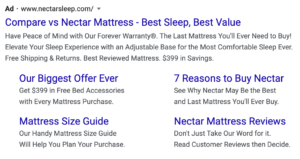Prospective customers often compare products before they make a purchase. Use this pattern to get in front of them during this crucial phase and remind them why your product is superior.
Why it’s a good idea
The evoked set is an academic concept within marketing. The textbook definition is:
brands that a buyer is aware of, and thinks well of, when considering a purchase; also called the Consideration Set.
Traditionally, the goal of many marketing campaigns has been to build awareness, and therefore become part of the evoked set. This pattern suggests an alternative path that allows you to inject yourself directly into the conversation as it’s taking place. No more relying on customers to remember who you are, or think to run a comparison against your product.
🌟 This Guide is Part of a Series of Marketing Patterns
For more free and ready to use marketing strategies just like this one, view the full marketing patterns library.
Strategy Analysis
Getting in front of customers
Most customers will rely on search engines to surface comparison content. Some subset of users may opt to do their own research, perhaps with a spreadsheet, but in our experience this has been limited to situations where no reasonably trustworthy content could be found in search. (note: this presents an excellent opportunity for content)
There are two core ways to get in front of these users:
- Paid Search
- Organic Search
Largely you’ll want to target queries like [competitor vs you], [you vs competitor product], though a hot tip is to also do [competitor A vs competitor B] (so many marketers forget about these).
Create landing pages that showcase the differences between your products. In our experience, those that convert well are fairly non-biased, or at least appear as such. You can control the conversation and show your products best characteristics by focusing on the criteria where you outperform.
The larger question (and idea for a/b testing) is whether or not your visitors that arrive from paid search are wiling to make a purchase after visiting the page. For many niches the answer is, “no,” in which case we recommend optimizing for a micro-conversion (an email opt-in for a significant coupon, or other attractive free offer).
Another pro tip is to break out a retargeting audience for your own customers and look for these types of queries. Running an RLSA (retargeting list for search ads) campaign can allow you to get in front of your own customers when they might be comparing you to a competitor. This can be a very good (albeit small) campaign for retention.
Positioning and Messaging
Don’t just go all out, guns blazing, and make your competitors look awful. Your prospective customers can see through this, so a more measured approach is often more believable (and less likely to get you into trouble).
Budget Considerations
On the paid search side, clicks can be expensive, particularly when showing this comparison content for competitor brand names. This is likely due to ad rank factors specific to on-page relevance. The good news is that these campaigns typically back out and achieve healthy ROI.
Starting with a small budget ($50-$100 per month) is absolutely within reason for niches without significant competitor query volume.
For organic search (SEO), the difficulty of ranking (and therefore the quality and amount of backlinks that will be required) scales in relation to how many affiliates and/or third party publishers also have comparison content. The good news is that in our experience, first-party comparisons (you vs competitor) can be ranked fairly quickly based on your domain + brand matchup. Third-party comparisons will prove more difficult, but can still leverage some domain/brand based authority and strength.
Tech and Tools
A general campaign can be built without any additional tech or services. However, in order to automate the discovery of new opportunities, such as new competitors, you may want to incorporate rss subscriptions to industry sites, or twitter tools.
Real World Examples
Here’s an example from the mattress space.

Here’s another example from the mattress space. Note that this is actually competitor vs competitor (loom and leaf vs casper, published on saatva).


